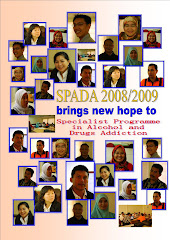THE CROSSROAD OF HARM REDUCTION AND
DEMAND REDUCTION SEMINAR 2008
THEME :
Harm Reduction and Demand Reduction : Crossroad Between Needs and Reality
DATE :
October 20 - 21, 2008
VENUE :
SCHOOL OF PSYCHOLOGY AND SOCIAL WORK,
UNIVERSITY MALAYSIA SABAH
ORGANISED BY :
SCHOOL OF PSYCHOLOGY AND SOCIAL WORK
UNIVERSITY MALAYSIA SABAH
WITH COOPERATION :
NATIONAL ANTI-DRUG OF MALAYSIA
DEMAND REDUCTION SEMINAR 2008
THEME :
Harm Reduction and Demand Reduction : Crossroad Between Needs and Reality
DATE :
October 20 - 21, 2008
VENUE :
SCHOOL OF PSYCHOLOGY AND SOCIAL WORK,
UNIVERSITY MALAYSIA SABAH
ORGANISED BY :
SCHOOL OF PSYCHOLOGY AND SOCIAL WORK
UNIVERSITY MALAYSIA SABAH
WITH COOPERATION :
NATIONAL ANTI-DRUG OF MALAYSIA
INTRODUCTION
Harm Reduction is based on the pragmatic acknowledgment that, despite years of trying, there are no known effective interventions for eliminating drug use or drug-related problems in any country, city, or community. In most cultures, adopting a harm reduction approach requires a shift in thinking away from deeply rooted, and understandable, long-term idealistic goals of eliminating drug use and getting all drug users to become drug free.
Harm reduction uses a wide range of services to achieve its goals. Needle exchanges and drug substitution therapy are the two of the most effective interventions to reduce drug-related harm. These are complemented by other supportive services for drug users such as health and drug education, HIV and STD screening, provision of condoms, psychological ccounseling, and medical referrals.
In Malaysia, Harm Reduction Programme has been carried out by multi-disciplinary departments from GOs and NGOs in the field of health, religious, enforcement and drug addiction since 2005. They play a very crucial and collaborative role in maintaining and expanding harm reduction efforts trough out the country.
On the other hand, the term "drug demand reduction" is used to described policies or programmes directed towards reducing the customer demand for narcotic drugs and psychotropic substances, which includes treatment and rehablitation as well as preventive education and information. Demand reduction programmes cover all ares of revention from discouraging initial use to reducing negative health and social consequences of drug abuse. It also incorporates information, education, public awareness, early intervention, counseling, tretment, rehablitation, relase prevention, aftercare and social reintegration.
OBJECTIVES
1. To enchance the understanding and knowledge of the participants regarding harm reduction and demand reduction programmes.
2. To enchance the skills of the participants in harm reduction and demand reduction programmes.
3. To yield the importance of both approaches in combating the drug problems.
4. To help the participants in forming in forming relevant effective strategies for both approaches.
METHOD
Seminar and workshops
SPEAKERS
International and local specialists in drug addiction.
SEMINAR PROGRAMME
DAY 1
0800 Registration of Participants
0830 Keynote address
0930 Plenary Session 1 - Drug Law and Policy
1030 Tea Break
1100 Plenary Session 2 -
Current Practices in Harm Reduction and Demand Reduction
1200 Plenary Session 3 -
Practising of Harm Reduction and Demand Reduction in Malaysia :
Opportunities and Challenges
0100 Lunch Break
0230 Workshop 1 : Law and Policy
0730 Opening Ceremony and Dinner
DAY 2
0830 Workshop 2 : Forum Session
1030 Tea Break
1100 Resolation
1200 Closing Ceremony
End of Seminar
Harm Reduction is based on the pragmatic acknowledgment that, despite years of trying, there are no known effective interventions for eliminating drug use or drug-related problems in any country, city, or community. In most cultures, adopting a harm reduction approach requires a shift in thinking away from deeply rooted, and understandable, long-term idealistic goals of eliminating drug use and getting all drug users to become drug free.
Harm reduction uses a wide range of services to achieve its goals. Needle exchanges and drug substitution therapy are the two of the most effective interventions to reduce drug-related harm. These are complemented by other supportive services for drug users such as health and drug education, HIV and STD screening, provision of condoms, psychological ccounseling, and medical referrals.
In Malaysia, Harm Reduction Programme has been carried out by multi-disciplinary departments from GOs and NGOs in the field of health, religious, enforcement and drug addiction since 2005. They play a very crucial and collaborative role in maintaining and expanding harm reduction efforts trough out the country.
On the other hand, the term "drug demand reduction" is used to described policies or programmes directed towards reducing the customer demand for narcotic drugs and psychotropic substances, which includes treatment and rehablitation as well as preventive education and information. Demand reduction programmes cover all ares of revention from discouraging initial use to reducing negative health and social consequences of drug abuse. It also incorporates information, education, public awareness, early intervention, counseling, tretment, rehablitation, relase prevention, aftercare and social reintegration.
OBJECTIVES
1. To enchance the understanding and knowledge of the participants regarding harm reduction and demand reduction programmes.
2. To enchance the skills of the participants in harm reduction and demand reduction programmes.
3. To yield the importance of both approaches in combating the drug problems.
4. To help the participants in forming in forming relevant effective strategies for both approaches.
METHOD
Seminar and workshops
SPEAKERS
International and local specialists in drug addiction.
SEMINAR PROGRAMME
DAY 1
0800 Registration of Participants
0830 Keynote address
0930 Plenary Session 1 - Drug Law and Policy
1030 Tea Break
1100 Plenary Session 2 -
Current Practices in Harm Reduction and Demand Reduction
1200 Plenary Session 3 -
Practising of Harm Reduction and Demand Reduction in Malaysia :
Opportunities and Challenges
0100 Lunch Break
0230 Workshop 1 : Law and Policy
0730 Opening Ceremony and Dinner
DAY 2
0830 Workshop 2 : Forum Session
1030 Tea Break
1100 Resolation
1200 Closing Ceremony
End of Seminar


No comments:
Post a Comment